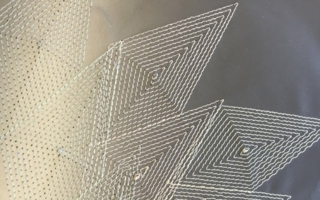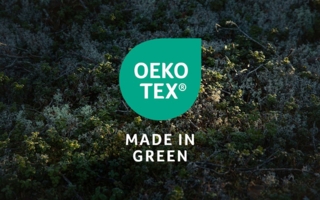18/05/2018 – P. Manvi, T. Gries
Advances in polyurethane filaments
Aim of this article is to present an overview of recent advancements in polyurethane filaments. Conventionally raw materials of Polyurethane filaments are produced from petroleum. Conventional polyurethane filaments are produced in dry spinning process. Deplating resources of petroleum and increasing awareness about environmental issues pose need of atlernative sustainable materials and processes. Recents advancements in sustainable production of Polyurethane filaments are presented in this article.
Polyurethanes (PUs) were discovered originally in 1937 by Otto Bayer and coworkers in I.G. Farben in Leverkusen, Germany[1]. Polyurethane filaments are getting attraction in manmade fibre industry due to their excellent extensibility and elastic properties. Elastic filaments are an integral part of elastic clothing. According to a study, elastic filaments are used in 80 % of clothing textiles in American market[2]. Global clothing market has reached 1,685 billion dollar in 2015 and expected to increase until 2025[3] and thus proves potential of polyurethane filaments in global textile market. Polyurethanes are chemically composed of polyols and isocyanates. Polyols contribute in elongation and therefore called as soft segments. Isocyanates contribute in tensile properties and therefore referred as hard segments. A combination of soft and hard segments offers unique properties like high elongation and elasticity to polyurethane filaments. Conventionally polyurethane filaments are spun using dry spinning process, which covers 80 % of global polyurethane filament production. In dry spinning process, polyurethane filaments are dissolved in solvent like dimethylformamide (DMF) and Dimethylacetamide (DMAc) to prepare a polymer dope consisting of 20 – 25 % polymer. Polymer dope is extruded through spinnerets having 5 – 112 holes for multifilament spinning and 1 hole for monofilament spinning. Liquid filaments are passed through quenching chamber, where solvent is evaporated using hot air and solid filaments are formed. A spin finish is applied on filaments and filaments are collected on a winder[4]. Properties of conventional elastane (trade name of PU filaments) are reported in table. 1.
Table. 1: Properties of conventional elastane filament
Property |
Value |
Tenacity at break (cN/tex) |
5 - 12 |
Elongation at break (%) |
400 - 800 |
Elastic modulus (cN/tex) |
0.5 - 1 |
Conventionally polyurethane was synthesized from petroleum based raw materials. Depleting sources of petroleum oil and negative influences of solvent in filament production pose threats for the sustainable production of polyurethane filaments. Therefore several material oriented and technical advancements are performed in recent years, which are listed below:
- Bio-based raw materials for polyurethane production: Alternatives of polyols content in polyurethanes are identified as bio-based content. This approach enables development of partial bio-based polyurethanes. An American company Lubrizol Corporation, Ohio, USA has been successful in commercializing bio-based polyurethanes with bio-based content up to 70%[5]. Company is trading bio-based polyurethanes under trade name of Pearlthane™ ECO and Pearlbond™ ECO5. Company has also developed spinning process for bio-based polyurethane and thus is capable of trading partially bio-based polyurethane filaments. Plant oils are being used in majority for production of bio-based polyols[6], [7].
- Carbon-dioxide based polyurethanes: Development of polyurethanes synthesized from carbon dioxide based polyols has already been reported in several publications[8], [9]. Company Covestro AG, Leverkusen has been successful to produce polyurethanes from carbon dioxide based polyols[10]. Company has also reported filaments made of carbon-dioxide based polyurethane.
- Melt spun polyurethane filaments: Melt spun polyurethanes are reported in patents[11], BASF SE, Ludwigshafen, Germany has also reported melt spun polyurethane filaments and thus offers advantage of solvent-free spinning[12].
Thus, this study reports sustainable advancements in development of polyurethane filaments using bio-based, carbon dioxide based raw materials and solvent-free filament spinning.
[1] Sharmin, E.; Zafar, F.: Polyurethane: An introduction, In: Sharmin, E.; Zafar, F. (Eds.) Polyurethane, London: InTech, 2012, pp. 3-16
[2] https://www.npr.org/2011/12/11/143003539/spandex-has-stretched-with-u-s-waistlines, last visited on 26.04.2018
[3] https://www.statista.com/statistics/279757/apparel-market-size-projections-by-region/, last visited on 26.04.2018
[4] Fabricius, M.; Gries, T.; Wulfhrost, B.: Fiber Tables: Elastan Fibers (spandex), Frankfurt am Main, Schwenk & Co. GmbH, 1995
[5] https://www.lubrizol.com/Engineered-Polymers/Technologies/Innovative-Materials/Bio-TPU, last visited on 27.04.2018
[6] Javni, I.; Petrović, Z.S.; Guo, A.; Fuller, R.: Thermal stability of polyurethanes based on vegetable oils, Journal of Applied Polymer Science 77 (2000), No. 8, pp. 1723 - 1734
[7] Lligadas, G.; Ronda, J.C.; Galià, M.; Cádiz, V.: Oleic and undecylenic acids as renewable feedstocks in the synthesis of polyols and polyurethanes, Polymers 2 (2010), No. 4, pp. 440-453
[8] Orgiles-Calpena, E.; Aran-Ais, F.; Torro-Palau, A. M.; Montiel-Parreno, E.; Orgiles-Barcelo, C.: Synthesis of polyurethanes from CO2-based polyols: A challenge for sustainable adhesives, International journal of adhesion and adhesives 67 (2016), pp. 63-68.
[9] Alagi, P.; Ghorpade, R.; Choi, Y. J.; Patil, U.; Kim, I.; Baik, J. H.; Hong, S. C.: Carbon Dioxide-Based Polyols as Sustainable Feedstock of Thermoplastic Polyurethane for Corrosion-Resistant Metal Coating, ACS sustainable chemistry engineering 5 (2017) 5, pp. 3871-3881
[10] https://www.covestro.de/en/projects-and-cooperations/co2-project, last visited on 27.04.2018
[11] Vedula, R. R.; Xia, Y.; Melt spun TPU fibres and process, US patent US7357889B2
[12] https://www.plasticsportalasia.net/wa/plasticsAP~en_GB/portal/show/content/plasticsportal_news
/2014/14_151a, last visited on 27.04.2018



